We may earn revenue from the products available on this page and participate in affiliate programs. Learn More ›
A few years ago, a company known primarily to competitive shooters as STI underwent a change in ownership and emerged as Staccato. STI earned its name in the competitive pistol arena with their 2011 series of pistols. A 2011 is essentially a slicked up 1911 with big magazines, made for those chasing the utmost in performance in practical competitions, particularly in USPSA/IPSC and 3-gun. However, recognizing the limited size of the competitive pistol market relative to the broader firearm landscape, the company decided to broaden into concealed carry and duty pistols, giving rise to the Staccato P as its do-all model. (Staff writer Tyler Freel also did an in-depth review of the Staccato P that’s worth checking out.)
As someone who has long favored Glocks and has a fair amount of time with single-stack 1911s, I had decided to give the 2011-pattern pistols a try, hoping for the enhanced accuracy and performance the pistol is known for. While I never felt a pressing need for a 2011, my curiosity in firearms had led me to explore other polymer and striker-fired options before realizing they didn’t offer enough to move me away from the Glock platform. During the pandemic I sold some gear and used those funds to dive into the 2011 world. I opted for the Staccato P as it seemed to be exactly what I wanted. Even though the supplies were constrained I ended up tracking one down via Gunbroker. (One note: I purchased my pistol in 2020 in an iron-sight only configuration. Staccato has since standardized the P model with their optic cut.)
- Caliber: 9mm
- Capacity: 17+1 or 20+1
- Action: Single-action, hammer-fired
- Barrel: 4.4-inch, bull profile, stainless steel
- Dimensions: 8.1 inches (L) x 5.8 inches (H) x 1.3 inches (W)(grip)
- Weight: 37 ounces (with empty 17-round magazine) (measured)
- Frame: 4140 billet steel (aluminum models available)
- Slide: 4140 billet steel
- Optics: Cut for optic, uses Dawson Precision optic system
- Controls: Right-handed slide stop, mag catch, ambidextrous safety levers
- Finish: Black DLC
- Grip: Polymer grip module, laser-etched stipple texture
- Sights: Dawson Precision fiber-optic front, serrated black square-notch rear (drift adjustable)
- Trigger: 1911-style single-action, curved shoe, 4 pounds, 2 ounces (measured)
- MSRP: $2,499
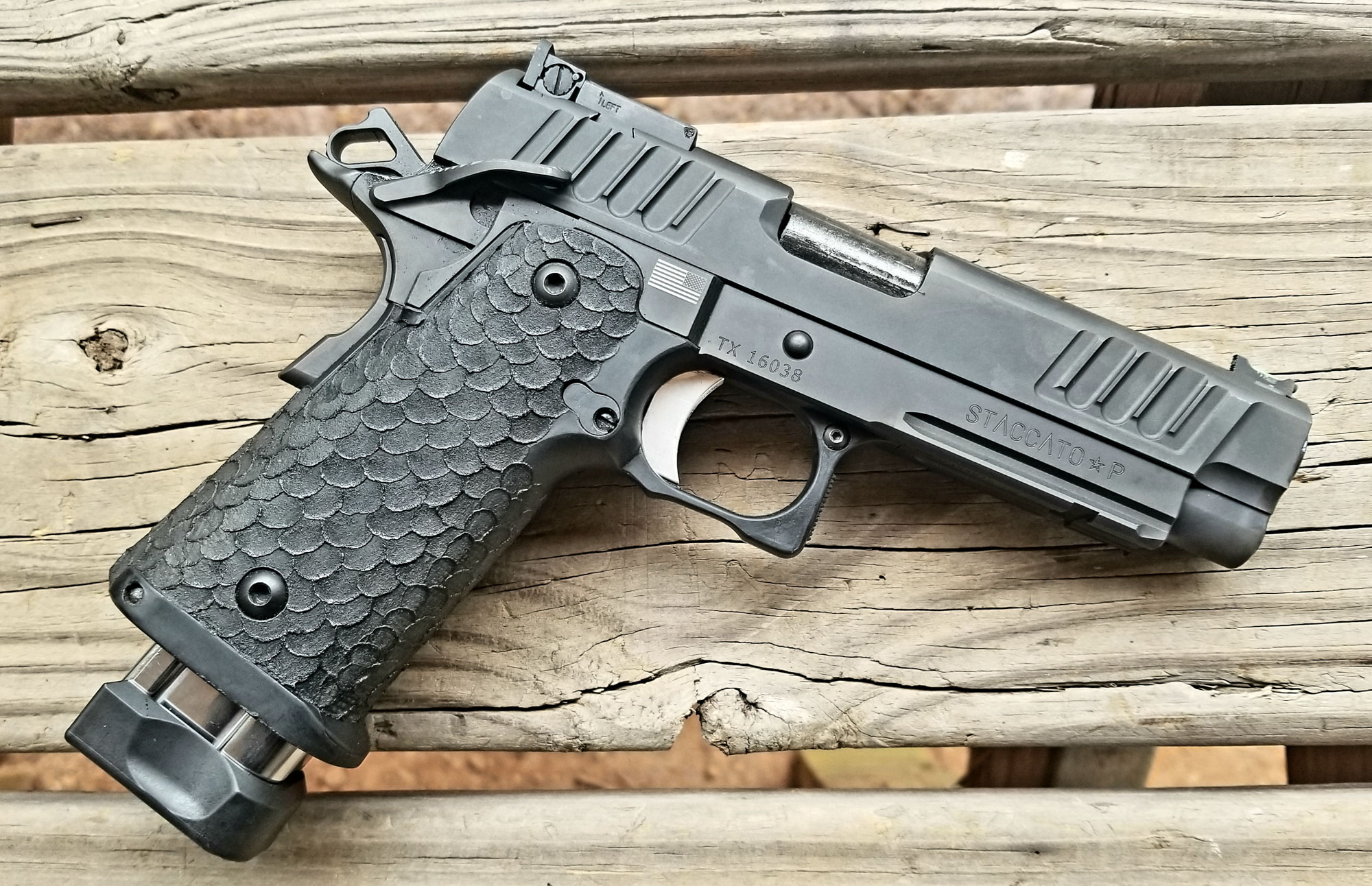
Once I had the pistol in hand, I couldn’t resist making a few tweaks. While I typically advocate shooting a new pistol as-is, my experience allowed me to quickly pinpoint what I wanted to alter. One notable change when STI became Staccato was the introduction of the Gen 2 polymer grip for the 2011 platform, boasting a reinforced magazine latch area and a different texture. I opted to switch to the older-style Gen 1 grip with Xtreme Shooters’ Dragon Scale texture, a feature seen on several earlier STI models. Having handled both versions, I simply preferred the feel of the older grip.
I also swapped the sights, opting for a slimmer front blade from Dawson Precision (.090” wide compared to the .125” wide stock sight) and a narrower rear notch from Brazos Precision. These modifications were to squeeze out a bit more precision for particularly challenging targets. Additionally, I replaced the stock trigger on the Staccato with the shorter, metal X-Line Vario by Geppert (imported by Atlas Gunworks). While the stock trigger was perfectly fine for standard shooting, I found it slightly too long for my liking when shooting with just one hand. The new trigger has been exceptional, and I’ve grown to appreciate its width and feel.
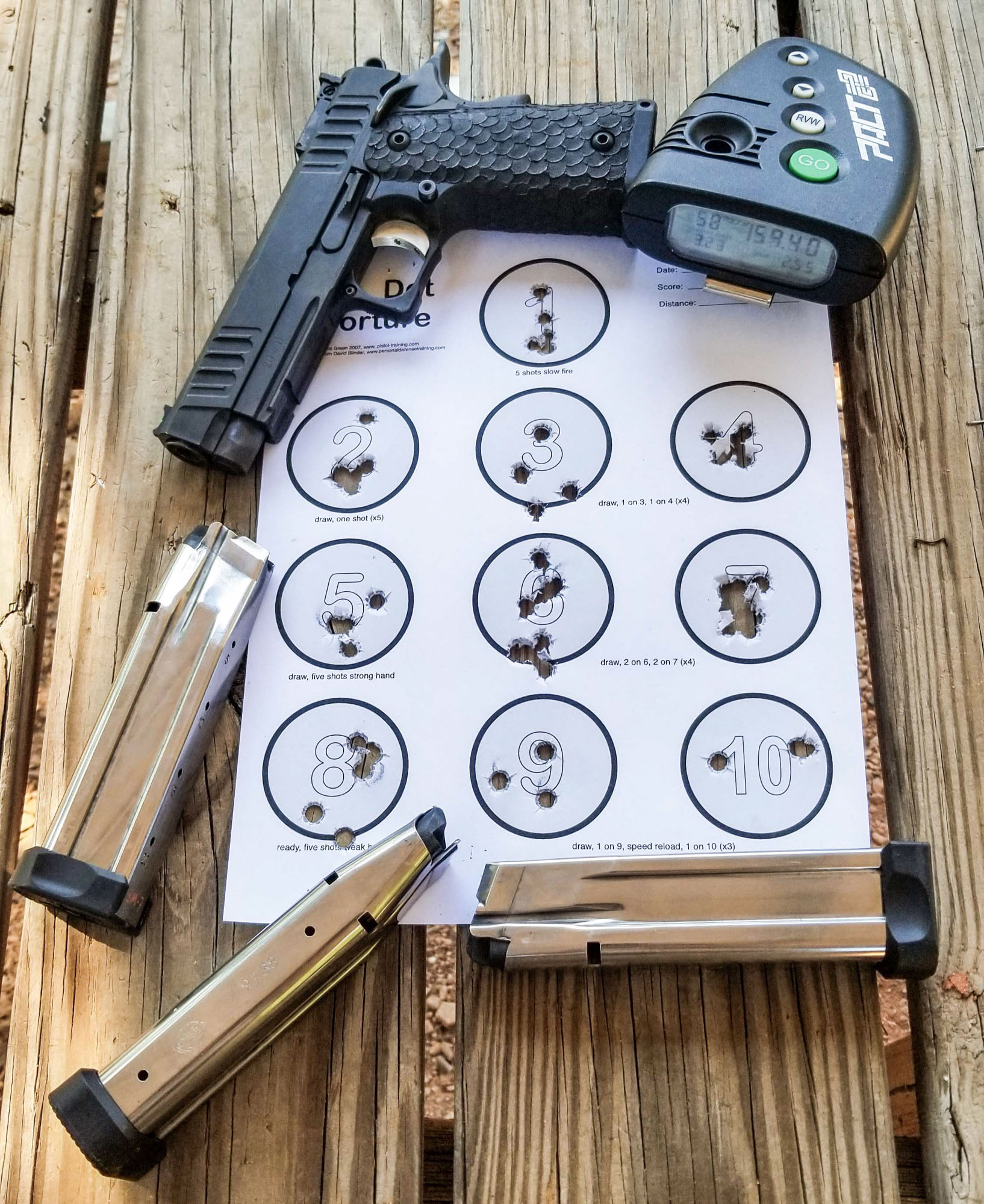
Staccato P Endurance By The Numbers
I picked up my Staccato P in April of 2020. For this pistol I decided to be as meticulous in my record keeping as I would with a precision rifle, and it took until September of 2022 to reach the 20,000 round mark. Here are a few stats from that time:
- Most Rounds in a Day: 1,071
- Most rounds fired without cleaning: 2,852
- Average rounds fired between cleanings: 1,216
- Gun caused malfunctions: Five traced to one problem magazine, one to a very dirty and dry pistol, and one to a broke extractor at approximately 19,500 rounds.
- 18 Matches including Run-n-Guns, Sniper Challenges, Gas Gun, and Team Matches
- Farthest Hit on Target: 360 yards on full-size IPSC torso with 125-grain Hornady HAP
- Other Maintenance: I did replace the recoil spring at 10,484 rounds as preventative maintenance.
Overall Impressions of the Staccato P 2011
Staccato P Quality
I’ve had the privilege of owning, handling, and shooting a diverse array of pistols, ranging from exquisite hand-built masterpieces with premium price tags to, frankly, subpar bargain-basement options. Staccato firmly occupies a premium niche in the production pistol market. While customization options may be somewhat limited from the factory, their pistols boast an impressive spec sheet that would pique the interest of both competitive and defensive shooters.
When it comes to fit and feel, the precision is evident—the bull barrel fits snugly, the ambidextrous safeties are thoughtfully designed with a distinct, confident on/off action, and the slide-to-frame fit is tight without being too tight. Not a hint of lingering tooling marks or careless machining can be found, and the finish is consistently and expertly applied. In essence, for a pistol in the $2,000 range, it offers a lot.
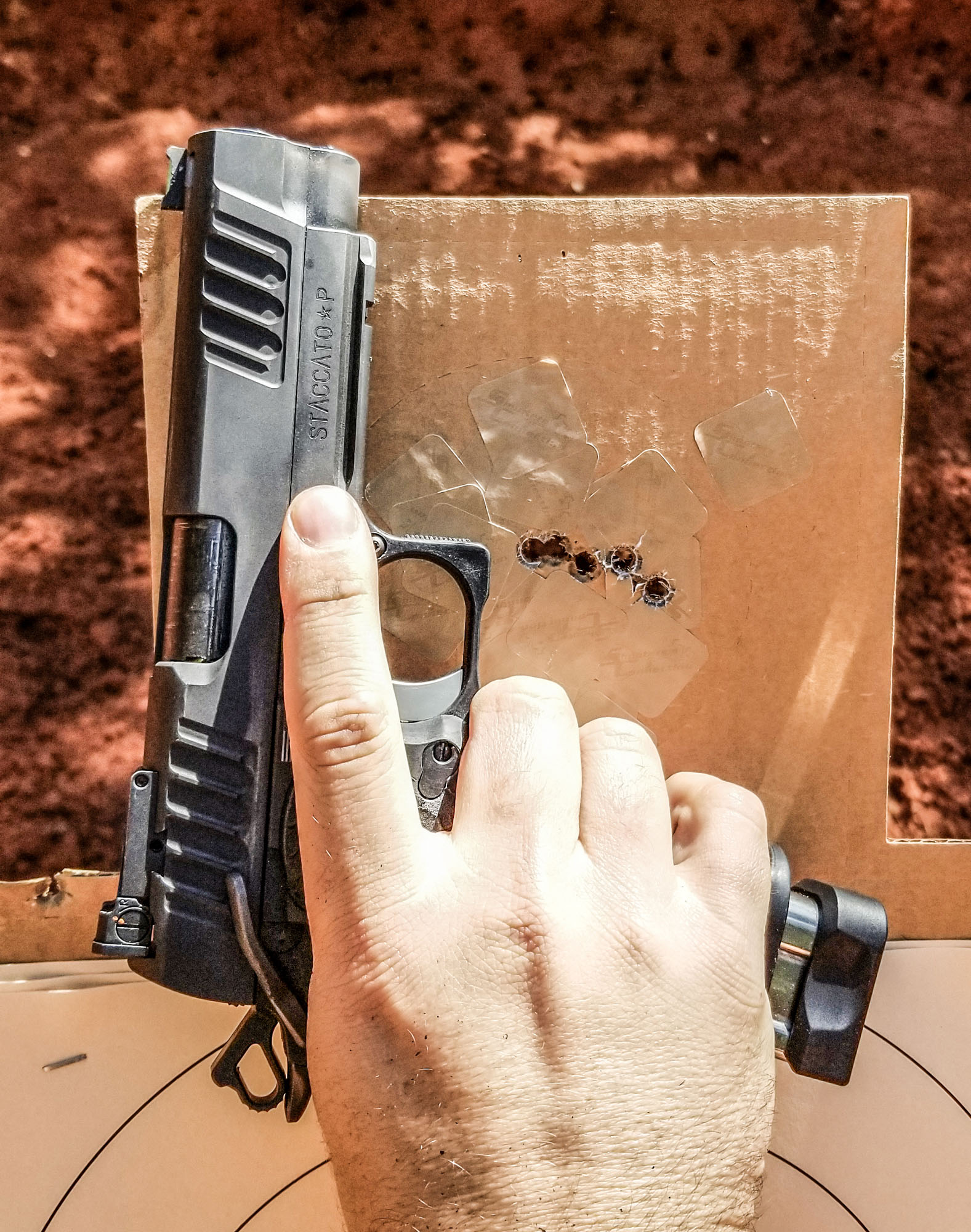
Staccato P Accuracy
One of my primary considerations in choosing a 2011 is the platform’s inherent precision capability. The Staccato P, with its barrel fit, ergonomic design, and crisp single-action trigger, not only boasts mechanical precision but also empowers the shooter to effortlessly tap into that level of performance. While I don’t rely on a Ransom Rest or favor bench-rested shooting, my accuracy benchmarks revolve around B-8 rapid fire bullseye centers, 8-inch steel plates, and USPSA cardboard target scoring rings, tested at various speeds and distances.
In summary, the Staccato P consistently outperforms my polymer pistols in terms of precision, particularly beyond 20 yards. While achieving high 90s or even a perfect score on a B-8 target with 10 shots at 25 yards might seem challenging with other handguns, the Staccato makes it feel attainable with proper focus on the iron sights. Moreover, executing first-round hits during walk-back drills from 50 to 60 yards on 8-inch steel plates is a common occurrence. Lastly, making hits beyond 100 yards on full-size torso targets is relatively straightforward. From a practical shooting perspective, the Staccato P’s accuracy capabilities often surpass my own skills.
Staccato P Reliability
While accuracy is undoubtedly important, a pistol’s functionality is paramount in my view; otherwise, it’s merely a paperweight. Adapting the 1911/2011 pattern pistols from their original .45 ACP design to 9mm required some refinement, especially concerning magazines. When STI introduced their Gen 2 (and now Gen 3) magazines, which required no extensive tuning, my interest in the pistol grew significantly. I had no desire to hassle with intensive magazine maintenance. The design also incorporates other thoughtful improvements, including a ramped barrel, a shorter, optimized barrel/slide length, and appropriately calibrated spring weights, all of which contribute to the reliability of these 9mm variants.

Ammo Selection
Throughout my shooting experiences, I predominantly used various 124/125-grain projectiles, with a particular preference for Hornady’s 125 grain HAP, 124 grain FMJ, and Brazos’ Bullets 124-grain coated bullets, all loaded over Hodgdon’s Titegroup or Hodgdon CFE Pistol powder. I’ve also experimented with everything from 95-grain plated bullets to 147-grain carry ammunition and even frangible rounds. I won’t claim the pistol always performed flawlessly, because it didn’t. However, the rare malfunctions I encountered were typically traced back to a specific magazine (marking your mags is a helpful practice) or ammunition-related issues, particularly with hastily loaded practice rounds that hadn’t undergone chamber checking.
At around the 19,500 round mark the extractor did break in half. On a 2011/1911, the extractor is a part that requires some gunsmith attention to fit to the specific pistol. To the credit of Staccato’s customer service, they were quick to get the pistol back to me in just a couple of weeks. I asked for a spare extractor fitted to the gun to keep handy for some of my adventures, of which was included in the box.
Dunked in Mud
My worst reliability experience with the Staccato P was an unusual situation during a run-and-gun event where I unintentionally immersed the pistol in thick mud. Despite my best efforts to clear it, the Staccato struggled to reset the trigger on its own. I removed the slide and flushed things with water to cycle it, yet I still had to manually reset the trigger by pulling it forward with every other shot. This understandably impacted my match performance, but I persevered without any stage disqualifications. Upon thorough disassembly at home, I discovered debris accumulation between the trigger bars and the frame, creating significant resistance and preventing the trigger from resetting. In fairness, the gun was in such a muddy state that most firearms would have faced similar challenges.
Setting aside the muddy ordeal, it’s worth noting that the 2011 platform, including the Staccato and similar models, demands slightly more care and attention compared to something like a Glock. While I’ve fired nearly 3,000 rounds without cleaning (but with some lubrication), the pistol does benefit from a bit of lubrication every few hundred rounds. Given the numerous metal parts in contact, as the gun accumulates dirt and dries out, you can feel the additional resistance to its otherwise smooth operation.
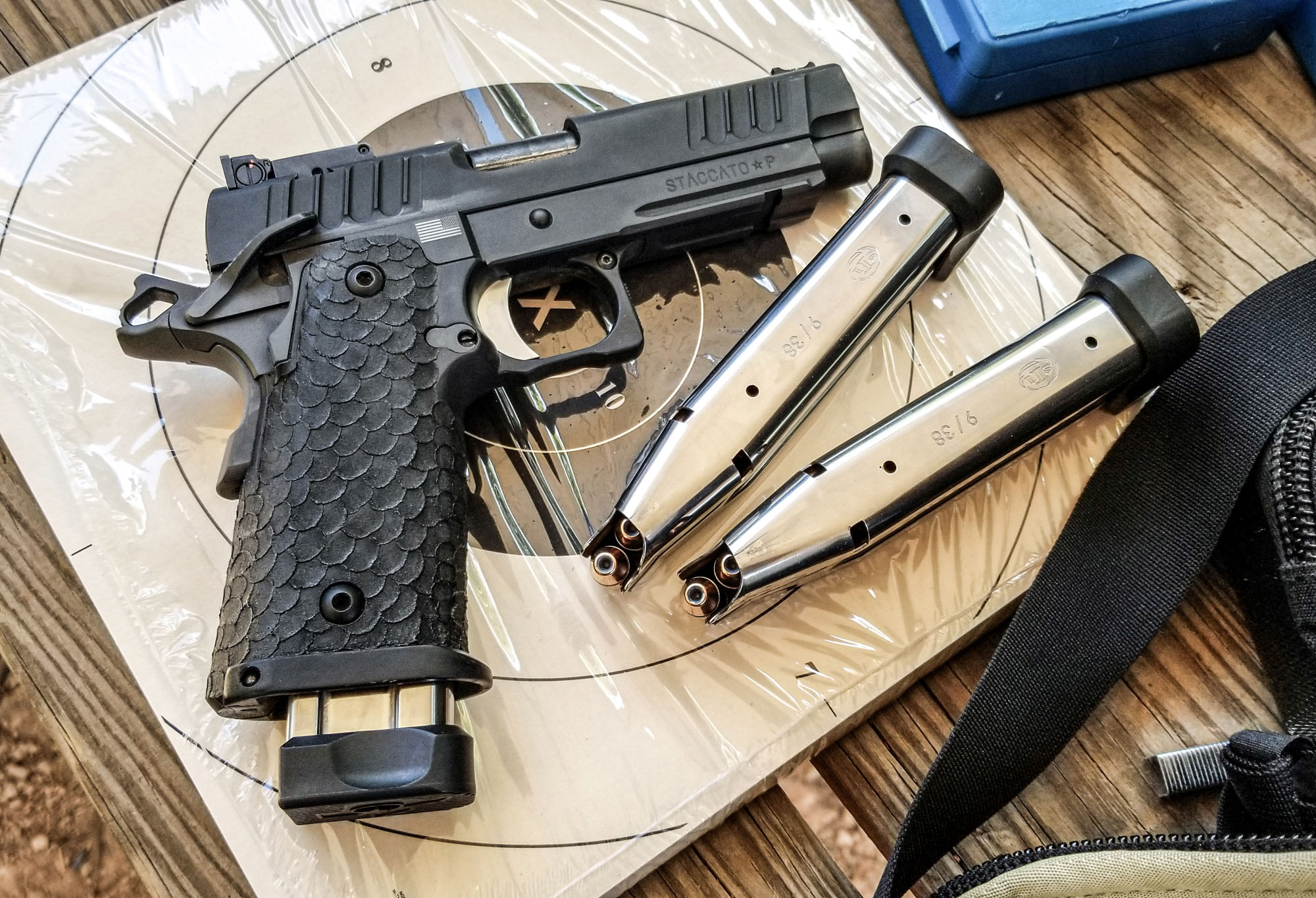
Enhanced Gen 2 Magazines
Magazines have historically posed a significant challenge for the 2011 platform, often necessitating tuning by a gunsmith or skilled user to match a specific pistol. However, the introduction of Staccato’s updated 9mm magazines has revolutionized the platform for consumers, making 2011’s—from the standpoint of reliability—less of a race-car and more of a daily-driver. The enhancements to the magazine include a change in the body shape and not requiring a spacer for the shorter 9mm rounds. Additionally, improvements to the follower, spring and baseplate have all found their way into the Gen 2 and now Gen 3 magazines. I’ve amassed a variety of these magazines, ranging from 17- to 26-round capacity, and they have all proven exceptionally reliable, even when subjected to dirt, moisture, and impacts on the ground. Even in light of their higher cost ($69.99 for a 20-round magazine) compared to more common polymer magazines, they are worth it.
In terms of maintenance, I typically disassemble the magazines for a wipe-down every 2,500 rounds or following exposure to significant moisture. Only one magazine spring showed minor signs of corrosion after getting soaked and left uncleaned for several days.
Staccato’s standard finish is a Diamond Like Carbon (DLC) coating. Despite being rained-on, snowed-on and sweat-on, I have not had any corrosion issues. Through thousands of kydex and Safariland retention-holster presentations the finish has held up very well. I like guns with some wear as it means they’ve been loved on…but it’s been difficult to make wear show up on the DLC treated metal parts.

Staccato P Viability For Everyday Carry
I have experimented with carrying the Staccato P as a concealed carry pistol. But there’s no denying that with a 4.4-inch barrel, steel frame and a topped-off 17-round magazine it is a beefy gun. In summer clothing it can be especially difficult to conceal. The extra layers typical in winter make it less of a chore. I’ve had the Staccato P in my Hill People Gear Runner’s Kit Bag on long runs/hikes, and while it fits, it’s still a big and heavy gun to strap on your chest. I would recommend checking out the Staccato C2 or newly-released Staccato CS if you’re interested in a smaller/lighter carrying 2011 pistol.
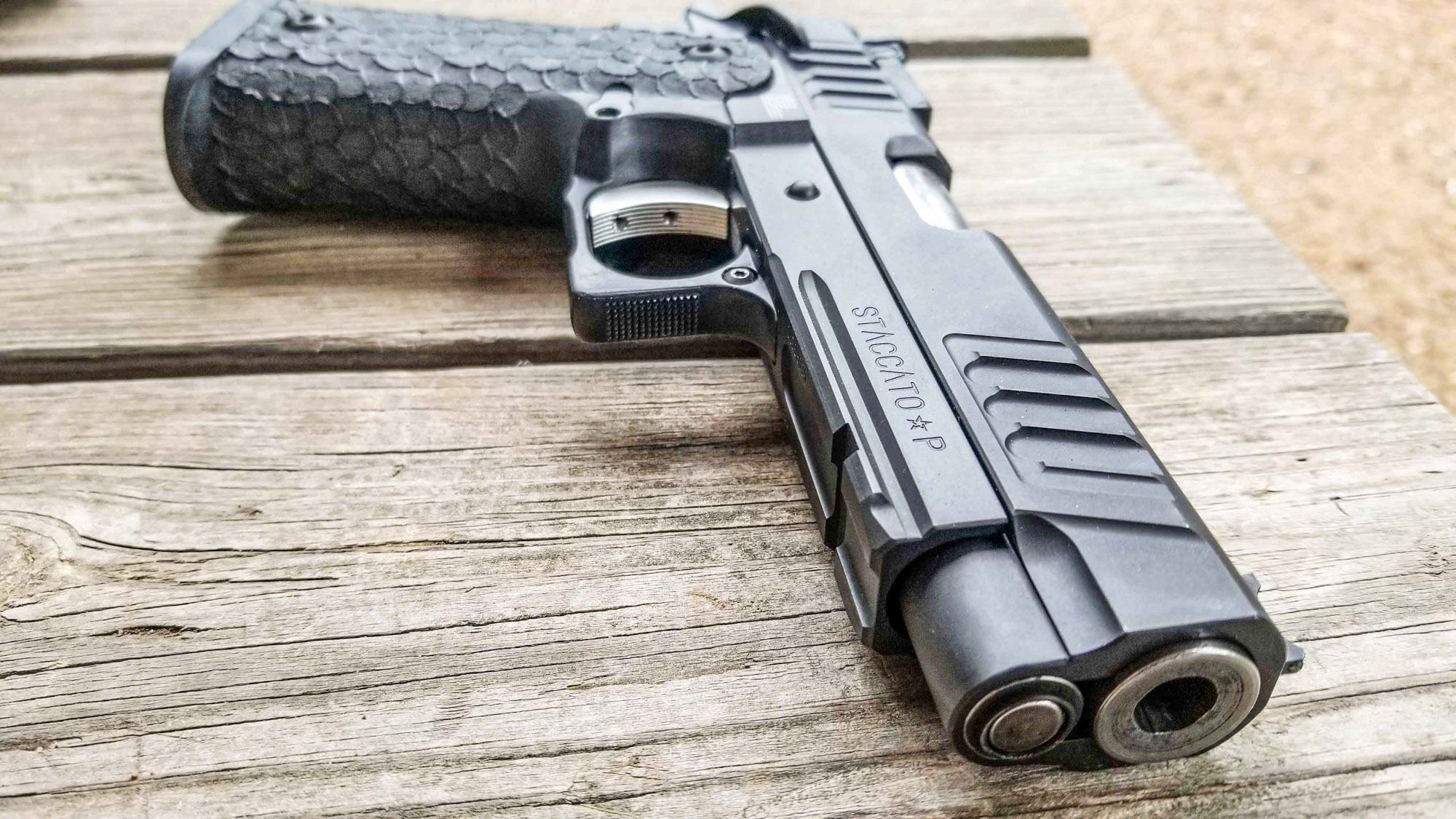
Staccato P Endurance Test Summary
It didn’t take long after getting it for the Staccato P to become my preferred pistol for recreational shooting and competitive use. While my trusty Glocks still have their place, the Staccato P has transformed me into a 2011 enthusiast. This design caters to those chasing superior performance. Shooting the Staccato P is a pleasure; it offers remarkable precision while also allowing for lightning-fast shots on target. Admittedly, achieving this level of performance demands a bit more care and maintenance, akin to maintaining a race car versus a daily driver. As Ken Hackathorn has noted, “If you treat your gun like you treat your lawnmower, get a Glock.” However, for those who truly value their pistol and its capabilities, the Staccato P is a compelling choice.
